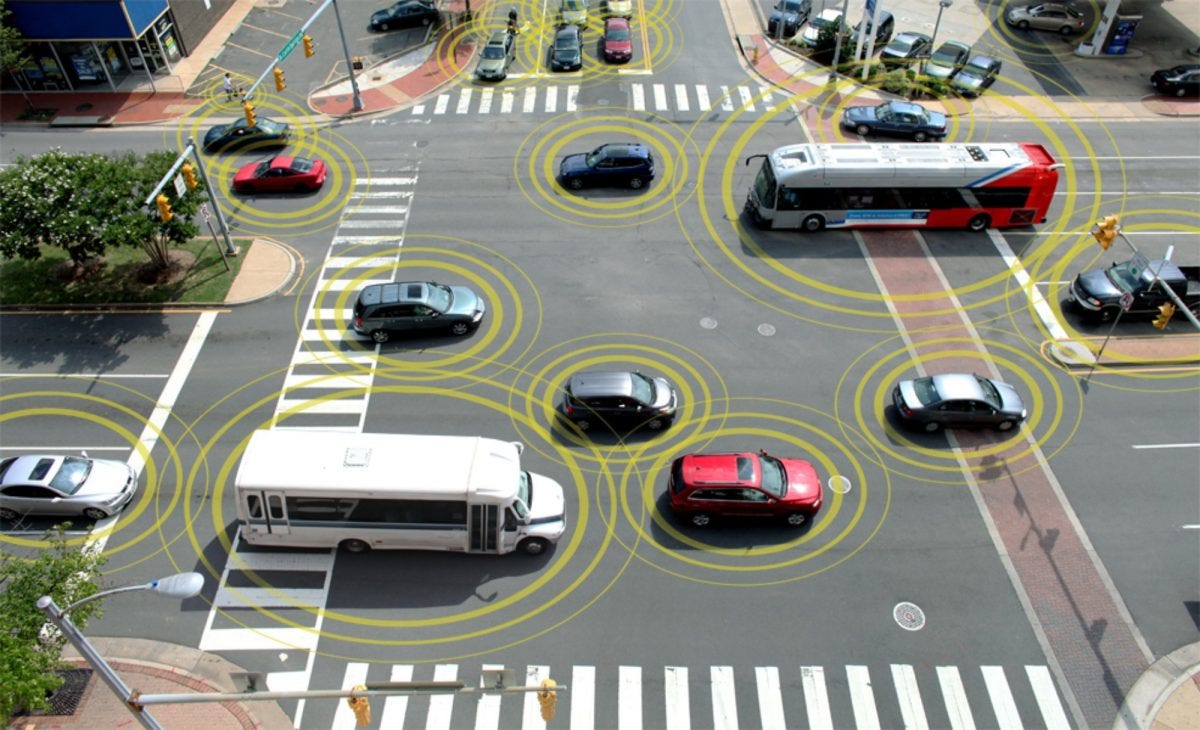Strategies for Embracing Connected Infrastructure
Balancing the Present with the Future of Transportation
In the pre-COVID-19 era, the buzz around connected and automated vehicles (CAVs) and their impact on city infrastructure was palpable. This hype drove my involvement in managing a project for the development of a CAV strategic plan for the municipality where I worked. Considering current technological constraints and shifting priorities due to the pandemic, the fervour around CAVs has dwindled in recent years. In my personal opinion, these vehicles may not become more widespread for another 10 to 20 years except for any major technological breakthroughs (such as improved Artificial Intelligence) in the interim. However, the focus remains on connected infrastructure and vehicles, with technologies like Signal Phase and Timing (SPaT) data and intersection geometry MAP data already in use, as demonstrated by municipalities including Ottawa.
The Dilemma of Investing in Connected Infrastructure
This raises a critical question: Should municipalities or provinces make significant investments in connected vehicle infrastructure now, or is this a decision to defer to the future? As we prioritize upgrades with more immediate benefits - such as traffic signals, active transportation, transit, and major corridor infrastructure - it's essential to weigh the benefits of investing in seemingly futuristic technologies that might offer little immediate value to the public. While I'm uncertain about the specific answer that any specific municipality should choose, delving into the business case considerations is crucial for informed decision-making.
The Importance of Municipal Commitment
For a municipality, commitment to CAV deployment doesn't mean putting CAVs first and foremost when we already have safety and operational challenges to overcome. Instead, the planning process should ensure proactive consideration of CAVs, avoiding reactive responses to unforeseen issues. Proper planning anticipates events, providing a contingency for those events before dealing with unexpected challenges.
This doesn't necessitate an immediate full-scale investment in CAVs. It requires carefully examining wholistic municipal goals and priorities (e.g. a City Council’s general strategic plan) before delving into CAV needs. Pilot corridors for connected infrastructure will likely require capital investment to implement but are crucial test beds for proof-of-concept technologies providing lessons learned ahead of broader deployment across a municipality.
Transition to Connected Infrastructure
Transitioning to support CAVs and connected infrastructure involves identifying pilot corridors or areas that provide good opportunities for proof-of-concept technologies and the lessons learned. Given the initial capital investments required for such test beds, clear implementation criteria and evaluation metrics should be developed to provide the best case possible for success.
Collaboration with prominent community partners will be key for early integration. For example, partnerships with universities and technical colleges with their research contributions and enthusiastic students, make excellent partners for exploring new technologies. Their involvement not only aids the municipality in understanding technology but also bolsters their investment and provides valuable experience for students and professors alike as they progress in their professional careers.
Secure Integration and Infrastructure Design Standards
Moving to the implementation and integration phase, policies for securely integrating connected infrastructure are crucial. Addressing concerns such as ensuring the legitimacy of connected infrastructure information is vital. For example, a connected vehicle needs assurance that the information indicating a green traffic signal comes from a legitimate traffic signal system. Transport Canada as of 2019 has engaged with Escrypt to develop a Security Credential Management System (SCMS) framework for future connected infrastructure systems. The timely, vital nature of information regarding the state of traffic signals (for example) will likely require a system that treats all participants (e.g. other vehicles, traffic signals, warning messages, etc.) as bad actors but that has a mechanism to easily verify the validity of such information. I expect that some combination of a cryptographic, trustless, and distributed system will be a likely candidate for such a task.
In the realm of design standards and guidelines, an emerging discussion is taking place at various organizational and governance levels. For example, data standards (e.g. SPaT, MAP, etc.) have been implemented in test cases in select municipalities across North America. New and revised guidelines will be required to supplement the existing Ontario Traffic Manual series, similar to what has occurred for other emerging technologies, such as bicycle signals. For example, enhanced pavement markings, signage, and geometric design best practices will need to be reviewed and reconsidered.
Collaborative Challenges and Risks
Active involvement in national and provincial committees, such as the Transportation Association of Canada's CAV Integrated Committee, is essential for industry guidance, lessons learned, and emerging best practices. No single municipality wants to front considerable capital costs to “reinvent the wheel” when other agencies may be separately attempting to learn the same lesson. Nonetheless, considering the test bed or pilot corridor concept discussed above, there is still value in local municipalities engaging in their lessons learned with their specific infrastructure systems and local policies that require consideration.
Given that connected infrastructure remains an emerging area, challenges and collaborative risks persist. For example, addressing cybersecurity risks, challenges in data exchange, and infrastructure vulnerabilities are paramount considerations.
Collaboration with provincial authorities, such as the Ministry of Transportation (MTO) in Ontario, is necessary. Their role in licensing and regulating automated vehicle technologies operating on the highway system is critical. This collaboration ensures a holistic approach to design guidance, insurance, and maintenance standards.
Final Thoughts
Preparing for the ultimate implementation of CAVs involves testing in a pilot corridor as a minimum path to this conclusion. Familiarizing oneself with the technology and its impact on resources is crucial, even with inherent risks. Future benefits, aligned with overall municipal commitments, priorities, and goals, will be invaluable. Patience, timing, ongoing collaborations, and adaptation to emerging industry developments will be key to success in the era of connected infrastructure.
What is your experience with connected infrastructure or connected and automated vehicles in general? How “all-in” should municipalities be at this stage of technology or shall we take a more measured, cautious approach through pilot corridors and areas within our cities?





